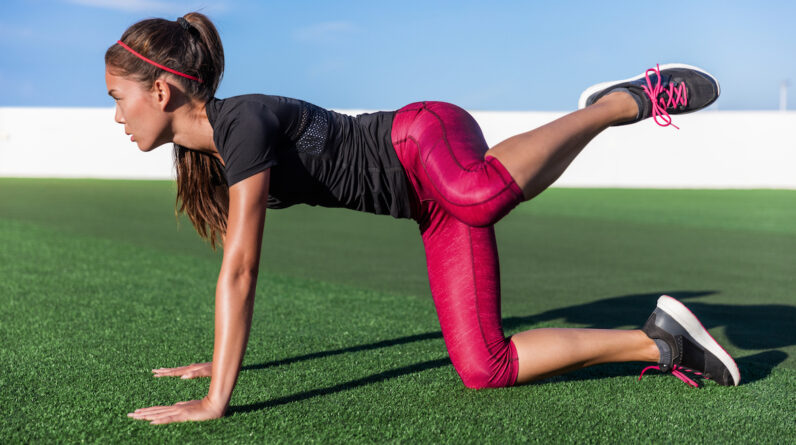
From downward dog to zoomies, dogs can be pretty good inspiration for fitness moves. Even Fido’s less, erm, genteel moments have something to teach us, like when dogs… go to the bathroom.
Sometimes dogs pop a squat to do their business (another staple exercise), but the iconic move is, of course, lifting their leg up to pee on a fire hydrant. Which is how the world of floor exercise got the killer “fire hydrant” leg lifting move. Usually done within a series on your hands and knees in a table top position, the fire hydrant works your glute medius, outer thigh, and core, according to celebrity fitness trainer and founder of The Sculpt Society Megan Roup.
“Hip mobility exercises like a fire hydrant are really great as a warm up for a run or if you’re looking to incorporate more targeted glute exercises into your routine,” Roup says.
It’s a simple exercise, but there are tips to put in place and pitfalls to avoid if you want to execute this dog-inspired movement in a way your pooch would be proud of.
How to do fire hydrants
- Start in a tabletop position on your hands and knees
- Keeping both your knees in a 90 degree bend, lift one of them out to the side, attempting to bring that knee in line with your hip.
- Lower it back down, but keep your weight in your arms and non-lifting leg (don’t put your weight back into the lifted leg when it returns to the floor).
Do 10 to 12 reps, then repeat on the other side.
Fire hydrant tips
Getting the most out the fire hydrant is all about activating your muscles (especially your core), maintaining proper form, and moving intentionally and with control. Otherwise you risk flailing your leg about for no real purpose—and without getting real results.
Avoid leaning away from the lifted leg
When you lift your leg, you want the rest of your body to stay in that hands-and-knees position, without shifting your weight and body.
“Because there is a lot of balance involved in a fire hydrant, clients naturally lean away from the lifted leg,” Roup says. “Think about plugging equally into both hands. This may mean your leg’s range of motion will be smaller, but you’ll also notice your core even more.”
Keep a neutral spine
Once again, it’s all about engaging that core. Rather than feeling yourself slip into an arched back, keep your spine in line with your head and hips.
Don’t forget about your upper body
The front part of your tripod may not be actively lifting during a fire hydrant, but that doesn’t mean it isn’t working.
“Think about staying active in your upper body, pressing through the floor and out of your shoulders,” Roup says.
Consider adding a resistance band
If you want to up the intensity of your fire hydrant, you can place a resistance band around your thighs above your knees, so when you lift your leg, it’s also working to pull that band apart. Just remember to keep all the above tips in mind so you’re not compensating for this added challenge with incorrect form.
Now you’re ready to make like Fido and get lifting. You may not feel the same relief as your dog does, but you’ll certainly feel the burn!
Want to work on your fire hydrant base? Master the table top position first.







